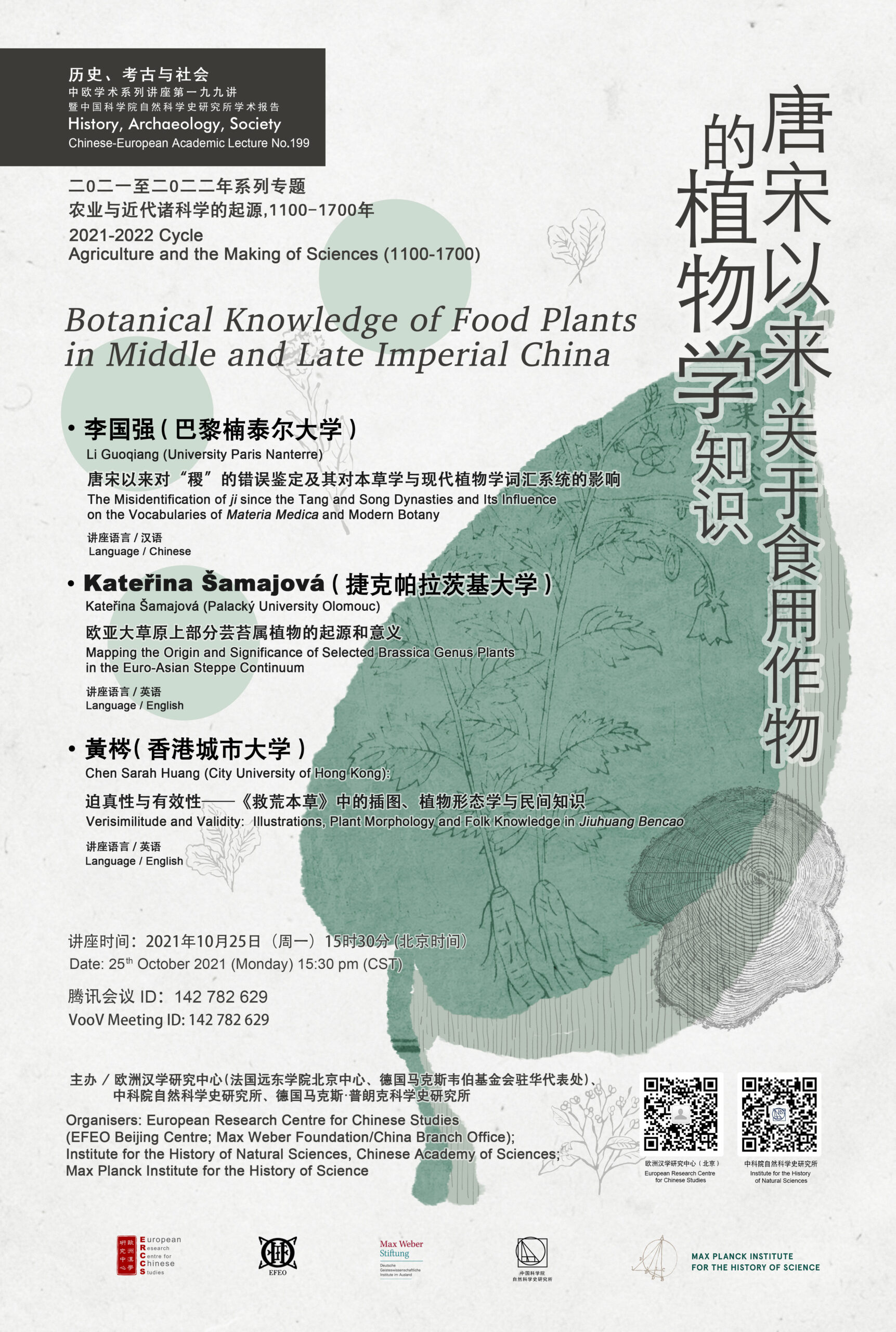Oct 25, 2021
Botanical Knowledge of Food Plants in Middle and Late Imperial China
- 09:30 to 11:30
- Seminar
- Dept. III
- Several Speakers
- Li Guoqiang (Paris Nanterre)
- Kateřina Šamajová (Palacky University Olomouc)
- Chen (Sarah) Huang
The Misidentification of ji since the Tang and Song Dynasties and Its Influence on the Vocabularies of Materia Medica and Modern Botany (Li Guoqiang)
The identification of the plant to which ji (稷) refers has been a major issue of debate for more than 1500 years. In the pre-Qin literature, the usage of ji is common knowledge and needs no explanation, but its linguistic context indicates that ji is foxtail millet (Setaria italica [L.] P. Beauv.). This correspondence is also clearly defined by Han scholars in their commentaries and dictionaries. However, by the 5th and 6th centuries AD, the herbalist Tao Hongjing (456–536) did not know what jimi (稷米) was, but speculated that it might be similar to millet (Panicum miliaceum L.). On this basis, the Tang Dynasty herbalists Su Gong (599–674) and Chen Zangqi (681–757) incorrectly identified ji as pancled millet (ji 穄) and broomcorn millet (mei 糜), which was later supported and further proved by Song dynasty scholars, while the Ming dynasty herbalist Li Shizhen identified ji as non-glutinous millet, which in turn became a professional term used in materia medica. The Qing dynasty scholar Cheng Yaotian (1725–1814) established a new explanation, when he erroneously considered ji to be sorghum (Sorghum bicolor L.), which has been embraced by many exegetes. Today, these two misidentifications have been extended into the modern botanical scholarship and have entered some agronomic and botanical monographs as scientific names, and also almost all common dictionaries give these two meanings for the term ji.
The present study examines the background and causes of these two misidentifications and the lack of relevant research methods, especially the role of Song and Qing dynasties academic thinking in their use of theories and methods, and then examines their influence on the vocabulary of materia medica and modern botanical vocabulary.
Mapping the Origin and Significance of Selected Brassica Genus Plants in the Euro-Asian Steppe Continuum (Kateřina Šamajová)
The Brassica genus without doubt represents one of the most economically important plant species known to man. The multi-faceted use of their leaves, roots, oil-bearing seeds, as animal fodder or for human consumption, is universally well documented.
This paper will attempt to shed some light into the origins of Brassica rapa by tracing its presence in the Chinese written canon. Owing to the alternative plant naming strategies employed by the Chinese language, mapping the history of culturally significant crops may be a complicated endeavour. This paper therefore proposes a multidisciplinary approach to studying such phenomena.
In this talk, the first attestations of Brassica rapa, var. chinensis will be introduced, including theories relating to the origin of names assigned to chinensis, as well as to other species related to the plant, both those genetically related, or sharing similar morphological features. This presentation will draw an analogy of the complicated relations in the Brassica genus by introducing the circumstances of its appearance in the European written history. By adopting the utilitarian approach to plants, the cultural significance of cabbages, as well as the features common to both European and Chinese varieties will be closely analysed.
Verisimilitude and Validity: Illustrations, Plant Morphology and Folk Knowledge in Jiuhuang Bencao (Chen Sarah Huang)
Jiuhuang bencao 救荒本草 (Materia Medica for Famine Relief or the Famine Herbal), published in 1406 in Kaifeng, Henan, was the first printed monograph on famine foods in China. The book listed 414 entries of edible plants that could be consumed in times of scarcity, fully illustrated with detailed texts about plant identification, nutrition, toxicity, and food processing. According to the preface, a botanical garden was set up and planted with specimens collected from local farmers, in order to facilitate meticulous observation and live drawing. As a result, the morphological texts and images in Jiuhuang bencao were of extraordinary quality, celebrated by both Ming contemporaries and modern botanists.
I will situate Jiuhuang bencao in the tradition of illustrated bencao and argue that, the book employed innovative textual and visual strategies to carry on the conventional function of bencao as a source of authority. Plant morphology was highlighted as a key to the task of zhengming 正名 (rectification of names) — maintaining the link between names and real entities, and personal experience with plants was emphasized as a valid source of knowledge. As an effort to formalize folk knowledge in the framework of bencao, the book constantly contested and developed the established knowledge about plants.

Contact and Registration
Open to the public online. To register, contact Chun Xu (cxu@mpiwg-berlin.mpg.de).
